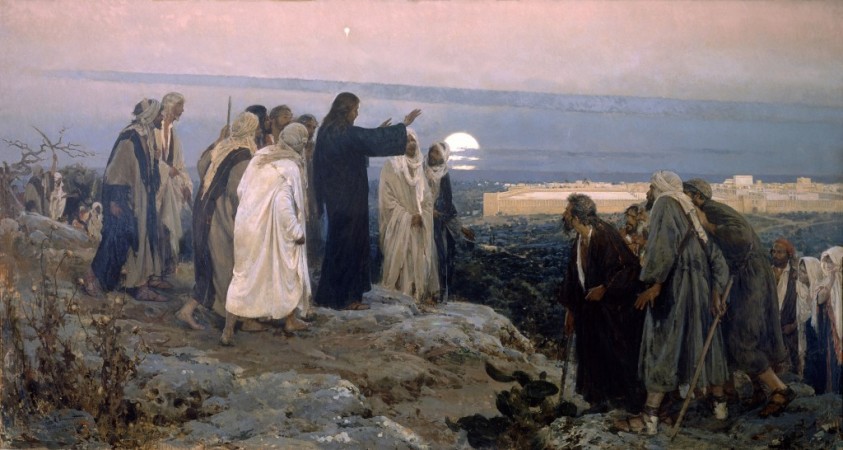If someone asked you who your favorite teacher was when you were growing up, chances are someone specific would come to mind. And chances are you still respect that person today not because he or she was a fantastic lecturer, or had a superior knowledge of the subject matter, or had a memorable voice. Our favorite teachers—the ones who influenced not just our thinking, but our lives—are usually those people who taught us about life. And it wasn’t just with their words. Their own lives were distinctive.

Jesus is widely considered the greatest teacher of all time. But we will only understand him in this capacity if we consider setting and context. Jesus was not a college lecturer or a mystical philosopher. Those who were under the teaching of Jesus were following him on foot, from one village to the next. They heard a parable when he walked into a field of grain, a discourse on being the bread sent from heaven after he fed a multitude, and debriefings with his disciples after many argumentative flareups with the Pharisees and teachers of the law. At a Jewish festival where water was used, he stood and said in a loud voice: “Let anyone who is thirsty come to me and drink” (John 7:37). Jesus’ teaching was dynamic and interactive. It spoke into both the practicalities of everyday life, and into cosmic, eternal issues.
No wonder people were amazed.
We’ll best appreciate the Gospels if we understand the forms of Jesus’ teaching and the main themes of his teaching. One form was exaggeration or hyperbole. Few believers have ripped out their eyes or cut off their hands because Jesus said in Matthew 5:29-30 that it would be better to do that then end up in eternal condemnation. We understand Jesus’ point, made through a shocking statement.
When Jesus said it is easier for a camel to go through the eye of a needle than it is for a rich person to enter God’s kingdom, his point was that it is extremely difficult for a self-sufficient person to admit their insufficiency. There is an often-repeated interpretation that in Jerusalem there was a small gate in the wall that necessitated a camel to go to its knees to enter. The problem is, there is no archaeological or epigraphical evidence that any such gate ever existed. Unfortunately, there are many interpretations of Scripture that have been repeated countless times but were never based in fact.
Jesus used similes and metaphors. “I am the light of the world” (John 8:12; 9:5). “I am the true vine” (John 15:1). “You are the light of the world” (Matt. 5:14). These have immediate impact, and they are memorable. Some of his most powerful metaphors explained the kingdom of God. The kingdom is like a mustard seed, leaven, a net, a man who finds a treasure, the sprouting of seed from the soil. These require careful reading. For instance, Jesus did not say the kingdom is like treasure, but it’s like what happens when a man finds a treasure and does everything to get it.
Jesus also spoke in short, memorable aphorisms or proverbs. “Do to others as you would have them do to you” (Luke 6:31). “Do not judge, and you will not be judged” (Luke 6:37). “Whoever does the will of my Father in heaven is my brother and sister and mother” (Matt. 12:50). Jesus acknowledged that he spoke figuratively for effect: “Though I have been speaking figuratively, a time is coming when I will no longer use this kind of language but will tell you plainly about my Father” (John 16:25).
Jesus spoke in riddles and he used irony. He used almost every kind of verbal method you could imagine, including parables (which we’ll come to in the next chapter). But the power of Jesus’ teaching for his original hearers and for us is not in the method. There was a ring of truth, a veracity, and a power in his teaching. For example, Matthew tells us, “When Jesus had finished saying these things, the crowds were amazed at his teaching, because he taught as one who had authority, and not as their teachers of the law” (Matt. 7:28-29). We would have been amazed too.
As with every other kind of text in Scripture, we need to take time to study the context of any given teaching of Jesus. To whom was he speaking? What were the circumstances? Were there any special cultural details? Even in the teaching of Jesus, Scripture means something specific to us that is based in what it meant to Jesus’ original audience. That is where we’ll find the true meaning, and thus, the authority.
Excerpt from How to Understand the Bible: A Simple Guide.
_________________________

Re: Undetstanding Jesus’ teachings. These are excellent and helpful guides for a clearer understanding of the Master’s teachings. We sometimes don’t factor in the fact Jesus lived 2000+ years ago in an alien culture, speaking a language foreign to us modern westerners.
Another fact we might consider is how Jesus addressed different audiences differently. For example, he said very contrary things to the Jewish leaders which were not meant for his disciples or the multitudes.
Speaking of multitudes, another example is the sermon on the mount. it is widely believed in this teaching Jesus was addressing the multitudes. The Koine Greek is clear however. The antecedent for those whom Jesus taught was not the multitudes, who were mentioned at the beginning of Matthew 5:1. His audience was the disciples who came to him after he sat down. After all, the sermon on the mount is very meaty and advanced stuff, not primarily designed for public consumption. This discourse is Discipleship 101 or 102 where Jesus begins his very important mission of training those men who will lead his mission to reach these these multitudes when he is gone.